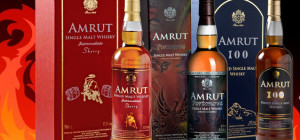India is a large consumer and producer of whisky. Many of the best-selling whisky brands in the world are produced and, for the most part, consumed in India. However, the definition and regulations concerning whisky in India are not the same as those used by the United States or the European Union. As such, much of the “whisky” produced in India is at least partially made with molasses-based neutral spirits. The best-selling brands of these whiskies include Officer’s Choice, McDowell’s No. 1, Royal Stag and Imperial Blue.
However, true whisky produced from grains and following standards equal to those employed by the United States and the European Union is produced in India and exported throughout the world. The first producer to make a true grain-based whisky in India was Amrut Distilleries. The company, located in Bangalore, was founded in 1948 by Neelakanta Jagdale.
In 2004, after producing rum and other spirits for several decades, Anmut Distilleries released a single malt whisky, made from 100% barley. Known simply as Amrut, it was ceremoniously first released in Glasgow, Scotland. This was followed by releases throughout much of Europe as well as Australia, North America, South Africa, and Asia.
The name Amrut comes from a Sanskrit word which may be translated as “nectar of the gods” or, as the company translates it, “elixir of life.” The story of the name, from Indian mythology, is as good as it gets: As the gods and the Rakshasas (the demons) churned the oceans using Mount Meru as a giant churner, a golden pot emerged from the waters containing the elixir of life. This elixir was called “Amrut.” (Western cultures would equate the “elixir of life” as the “fountain of youth” or “infinity formula.”)
Amrut is made from 100% barley. Most of the barley used is grown in India, however, for peated versions, some peated barley is imported from Scotland. The whisky is double-distilled in large pot stills before being diluted to 125 proof and aged in oak barrels for four years or longer. Surinder Kumar, the master blender at Amrut Distilleries, has estimated that because of climate differences, one year of barrel aging in India is equal to three years of aging in Scotland.
Amrut single malt whisky quickly became famous after being reviewed well by several well-known and respected whisky critics and publications. To name just one, Amrut Fusion Single Malt (based on a blend of Indian and Scottish barley), released in 2010, was named “World Whisky of the Year” by Malt Advocate magazine.
Amrut single malt whisky is now released in over 10 styles, including those aged in ex-Sherry barrels, those aged in ex-Bourbon barrels, peated versions, non-peated versions, cask-strength bottlings, and single barrel bottlings. There’s also a version called “Greedy Angels” (referring to the annual 10-12% “angel’s share” evaporation due to the tropical climate of the Bangalore distillery) that sounds amazing.
The distillery currently produces 4 million cases of liquor a year, including approximately 10,000 cases of Amrut single malt. Amrut is available in over 30 countries, including the UK, Canada, Japan, the US, and Australia. And for the adventurous traveler, the distillery tours look great!
References:
- Amrut Distilleries
- PVI Global (US distributor of Amrut)
- Click here for a video visit of Amrut Distilleries, created by WhiskyCast
Post authored by Jane A. Nickles – SWE’s Director of Education and Certification – jnickles@societyofwineeducators.org
Are you interested in being a guest blogger or a guest SWEbinar presenter for SWE? Click here for more information!

